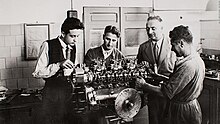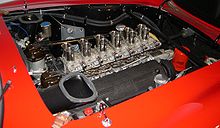Ferrari Colombo engine
This article needs additional citations for verification. (December 2018) |
| Ferrari Colombo engine | |
|---|---|
 Colombo engine in a 1961 250TR Spider | |
| Overview | |
| Manufacturer | Ferrari |
| Production | 1947–1988 |
| Layout | |
| Configuration | 60° V12 |
| Displacement | 1.5 L (1,497 cc) 2.0 L (1,995 cc) 2.3 L (2,341 cc) 2.6 L (2,563 cc) 3.0 L (2,953 cc) 3.3 L (3,286 cc) 4.0 L (3,967 cc) 4.4 L (4,390 cc) 4.8 L (4,823 cc) 4.9 L (4,943 cc) |
| Cylinder bore | 55 mm (2.2 in) 60 mm (2.4 in) 65 mm (2.6 in) 68 mm (2.7 in) 73 mm (2.9 in) 77 mm (3.0 in) 81 mm (3.2 in) 82 mm (3.2 in) |
| Piston stroke | 52.5 mm (2.1 in) 58.8 mm (2.3 in) 71 mm (2.8 in) 78 mm (3.1 in) |
| Cylinder block material | Aluminium |
| Cylinder head material | Aluminium |
| Valvetrain | SOHC, 24-valve DOHC, 24-valve |
| Compression ratio | 7.5:1 - 9.8:1 |
| Combustion | |
| Supercharger | Roots-type (in some versions) |
| Fuel system | Weber carburetor Bosch K-Jetronic FI |
| Fuel type | Petrol |
| Oil system | Wet sump Dry sump |
| Cooling system | Water-cooled |
| Output | |
| Power output | 116–395 hp (87–295 kW; 118–400 PS) |
| Torque output | 90–240 lb⋅ft (122–325 N⋅m) |
| Chronology | |
| Successor | Ferrari Lampredi V12 engine Ferrari flat-12 engine Ferrari F116 engine |
The Ferrari Colombo engine is a petrol fueled, water cooled, carburetted 60° V12 engine designed by Gioacchino Colombo and produced in numerous iterations by Italian automaker Ferrari between 1947 and 1988. The maker's first homegrown engine, its linear successor is the Lampredi V12,[1] which it far outlived, the last Lampredi being made in 1959.
Colombo, who had previously designed Alfa Romeos for Enzo Ferrari, placed bore centres at 90 mm apart, allowing for significant expansion. Displacements ranged from the diminutive 1,497 cc (1.5 L; 91.4 cu in) debut that powered the 125S racer to the 4,943 cc (4.9 L; 301.6 cu in) unit in the 1986 412i grand tourer. Significant updates were made in 1963 for the 330 series, featuring a redesigned block with wider, 94 mm, bore spacing.[2][3]
Enzo Ferrari had long admired the V12 engines of Packard, Auto Union, and Alfa Romeo[4] (where he was long employed), but his first car, the 1940 Auto Avio Costruzioni 815, used a Fiat derived straight-8. Development of the V12 Colombo engine continued long after Colombo had been replaced by Aurelio Lampredi as the company's marquee engine designer. Although the Lampredi V12 was a real force for the company, it was Colombo's engine which powered Ferrari to the forefront of high-performance automobiles through the 1950s and 1960s.
125
[edit]


The first Ferrari-designed engine was the 1,496.77 cc (1.5 L; 91.3 cu in) V12 125, the work of Gioacchino Colombo and assistants Giuseppe Busso and Luigi Bazzi.[1] The engine's name, and the car powered by it, the 125 S sports racer, were derived from the tiny 124.73 cc (7.6 cu in) 55 mm (2.17 in) by 52.5 mm (2.07 in) cylinders. The single overhead camshaft 60° V design had one cam on each cylinder bank, two valves per cylinder, and three 30DCF Weber carburetors. A 7.5:1 compression ratio yielded 118 PS (116 hp; 87 kW) at 6800 rpm. First appearing May 11, 1947, the engine allowed the company to claim six victories in 14 races that year.
Colombo and Ferrari had designed the engine with Formula One regulations in mind, and introduced it the next year in the company's first F1 car, the 125 F1. This time, it was supercharged, in accordance with F1 dictates, for a total output of 230 PS (227 hp; 169 kW) at 7,000 rpm. However, the single-stage Roots-type supercharger was incapable of producing the high-end power required to compete with the strong eight-cylinder Alfa Romeo 158 and four-cylinder Maserati 4CLT. Nevertheless, strong driving and a nimble chassis allowed the company to place third in its first outing, at the Valentino Grand Prix on September 5, 1948 and the company persevered in racing.
For 1949, the engine was further modified with dual overhead camshafts (though still two valves per cylinder) and a two-stage supercharger.[5] This combination gave the car better top-end performance and the resulting 280 PS (276 hp; 206 kW) gave it five Grand Prix wins. Development continued the following year, but the problematic superchargers were dropped in favor of larger displacement and Lampredi's 275 engine superseded the original Colombo design.
Applications:
- 1947 Ferrari 125 S — 118 PS (116 hp; 87 kW)
- 1948 Ferrari 125 F1 — Single supercharger, 230 PS (227 hp; 169 kW)
- 1949–1950 Ferrari 125 F1 — Dual-stage supercharger, 280 PS (276 hp; 206 kW)
58.8 mm stroke
[edit]



The early 166, 195, and 212 cars used Colombo V12s of varying sizes. All shared the same 58.8 mm (2.31 in) stroke, with 60, 65, and 68 mm (2.68 in) bores giving displacements of 1,995 cc (2.0 L; 121.7 cu in) in the 166, 2,341 cc (2.3 L; 142.9 cu in) in the 195 and 2,563 cc (2.6 L; 156.4 cu in) in the 212, respectively. Output ranged from 105 PS (104 hp; 77 kW) to 165 PS (163 hp; 121 kW).
250
[edit]One of the most common Colombo engines is the 250, which debuted in 1952 in the 250S and lasted through the 1963 330 America. It used a 73 mm (2.87 in) bore with the common Colombo stroke of 58.8 mm (2.31 in) for a total of 2,953 cc (3.0 L).
Beginning with the famous 250 TR, "Testa Rossa" racing car, Ferrari began a new series of modifications to the Colombo 250 engine. The spark plugs were moved to the outside of the cylinder head, near the exhausts. This enabled Ferrari to introduce separate individual intake ports to use with the six two barrel Weber carburetors. Four cylinder head bolts per cylinder were introduced (instead of three) to cope with the added power.[6]
These changes eventually were incorporated into the Ferrari road cars, beginning with the 250 GT SWB and the 250 GT Series II Pininfarina cars.[7][8]
275
[edit]The final 58.8 mm (2.31 in) Colombo Ferrari was the 275. It used a 3,286 cc (3.3 L; 200.5 cu in) variant of the V12 with a wide 77 mm (3.03 in) bore for up to 300 PS (296 hp; 221 kW).
330
[edit]The 1960 400 Superamerica replaced the previous model's Lampredi engine with a 3,967 cc (4.0 L; 242.1 cu in) Colombo. It diverged from the standard 58.8 mm (2.31 in) stroke with a 71 mm (2.80 in) stroke and 77 mm (3.03 in) bore. Output was 340 to 400 PS (335 to 395 hp; 250 to 294 kW) with triple Weber carburetors.
Although the 1963 330 series also used a 3,967 cc (4.0 L; 242.1 cu in) engine with the same bore and stroke as the 400 Superamerica, this 300 PS (221 kW; 296 hp) engine was quite different. It used a wider bore spacing, paving the way for future displacement increases. The spark plugs were moved and a new water pump was used. The dynamo on the prior versions was replaced by an alternator.
Four-cam
[edit]The Colombo V12 was substantially reworked for 1967's 275 GTB/4. It still used two valves per cylinder, but dual overhead cams were now used as well. In a departure from previous Ferrari designs, the valve angle was reduced three degrees to 54° for a more-compact head. The dual camshafts also allowed the valves to be aligned "correctly" (perpendicular to the camshaft) instead of offset as in SOHC Ferraris. It was a dry-sump design with a huge 16 L (17 US qt) capacity. The engine retained the bore and stroke dimensions of the 275 model for 3,286 cc (3.3 L; 200.5 cu in) of displacement. Output was 330 PS (325 hp; 243 kW) at 8000 rpm and 240 lb⋅ft (325 N⋅m) of torque at 6000 rpm with six 40 DCN 9 Weber carburetors.
365
[edit]The 330 Colombo engine was enlarged with an 81 mm (3.19 in) bore to 4,390.35 cc (4.4 L; 267.9 cu in) for 1966's 365 California, retaining single overhead cams and wet sump lubrication. A reworked engine with four camshafts was used in the GT/4 models. The 365 GTB/4 Daytona was the only 365 engined car featuring dry sump lubrication.
Applications:
- 1966–1967 365 California
- 1968–1970 365 GTC
- 1968–1972 365 GT 2+2
- 1968–1973 365 GTB/4 Daytona, 365 GTS/4 Daytona
- 1969 365 GTS[9]
- 1971–1972 365 GTC/4
- 1972–1976 365 GT4 2+2
400, 412
[edit]The wet sump, four-cam, 365 Colombo engine was enlarged again to 4,823.16 cc (4.8 L; 294.3 cu in) for 1976's 400 with the same 81 mm (3.19 in) bore and a 78 mm (3.07 in) stroke. The carburetors were replaced with Bosch K-Jetronic fuel injection in 1979. In 1986 the engine was bored to 82 mm (3.23 in) giving a displacement of 4,943.03 cc (4.9 L; 301.6 cu in).
Applications:
See also
[edit]References
[edit]- ^ a b "Ferrari 125 S". ferrari.com. Retrieved 11 July 2019.
- ^ "Ferrari 330 GT 2+2". Ferrari. Retrieved 16 June 2015.
- ^ Shea, Terry (September 2014). "1964 Ferrari 330 GT". Hemmings Motor News. American City Business Journals. Retrieved 16 June 2015.
- ^ Acerbi, Leonardo (2006). Ferrari: A Complete Guide to All Models. Motorbooks. p. 5. ISBN 9780760325506.
- ^ "The Story of the V12: The Engine That Made Ferrari". JBR Capital. Retrieved 2018-04-23.
- ^ "Ferrari 250 GT Zagato". FineSportsCars.com. Archived from the original on 2021-01-08. Retrieved 2020-05-31.
- ^ "Ferrari 250 GT Berlinetta Passo Corto". myAutoWorld. Retrieved 2020-05-31.
- ^ "Ferrari 250 GT Series II Story". Collezione by MS. Archived from the original on 2018-08-27. Retrieved 2020-05-31.
- ^ https://www.colomboandco.com/chronicles/colombo-engine
Bibliography
[edit]- Colombo, Gioachino (1985). Origins of the Ferrari Legend. Sparkford Nr. Yeovil, Somerset BA22 7JJ: Haynes Publishing Group. ISBN 0-85429-624-7.
{{cite book}}: CS1 maint: location (link)
